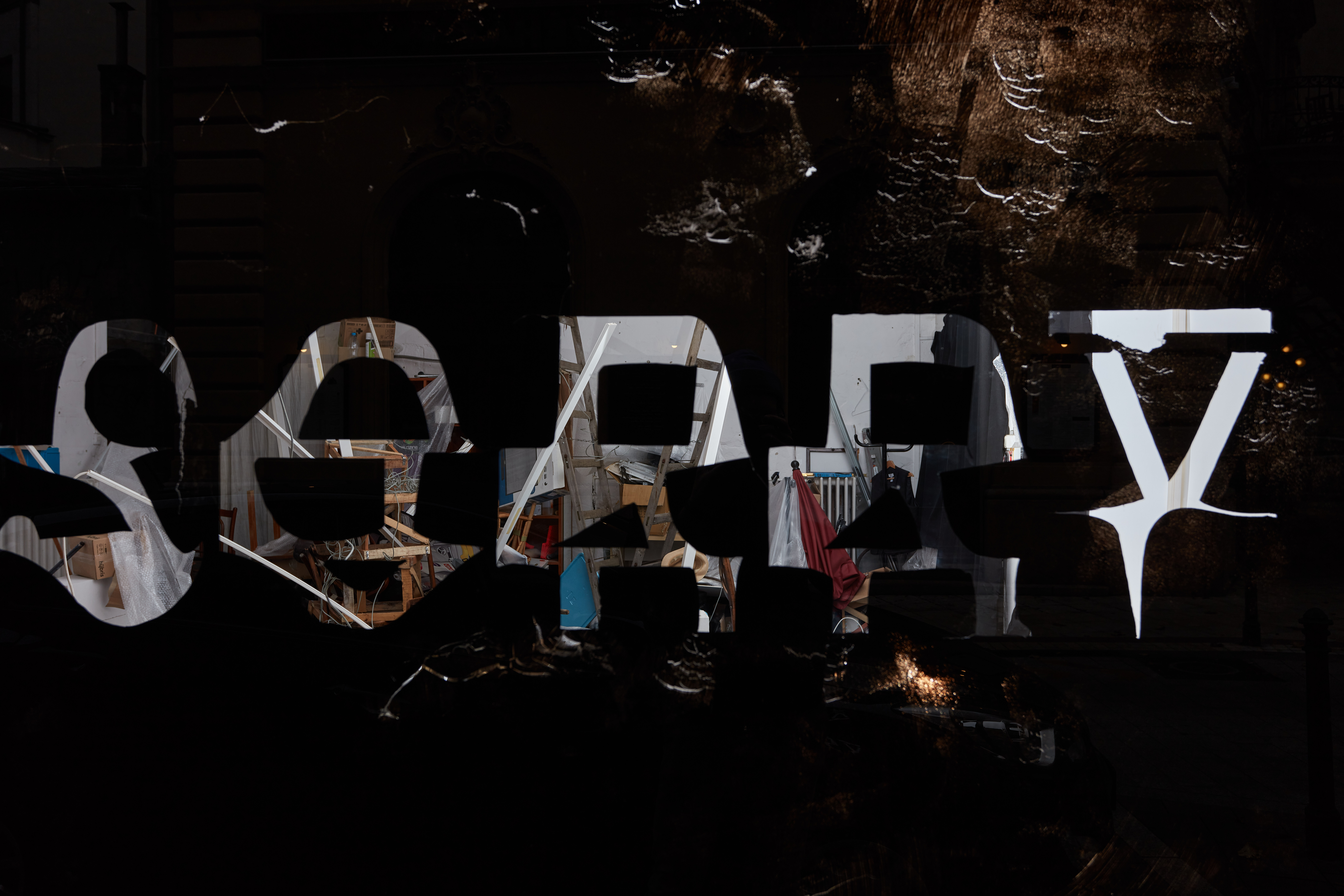Flash Show 0.
November 12-21, 2020
Venues: Gerbeaud Café I Toldi Club I Vitkovics Mihály utca 3-5. I Király utca 27. I Kecskeméti utca 14. (Mercure Hotel)
Exhibitors: Selma SELMAN – acb (HU) I Botond KERESZTESI- Everybody Needs Art/ ENA Viewing Space (HU) I Šimon SÝKORA – Polansky (CZ) I Jaroslav KYŠA – Zahorian & Van Espen (SK/CZ) I Saša TKAČENKO – Eugster II Belgrade (SRB) I BORSOS LŐRINC – Glassyard (HU) I Ada ZIELIŃKSA – Propaganda (PL) I Alexei GORDIN – Kogo (EST) I Simon KOCJANČIČ – Ravnikar (SLO) I Dimitrios ANTONITSIS – AETOPOULOS (GR) I Barna PÉLI- Easttopics (HU) I Jiří THÝN – Hunt Kastner (CZ)
Photo: Dávid Bíró
Curators: Fruzsina Kígyós, Alexandra Nagy
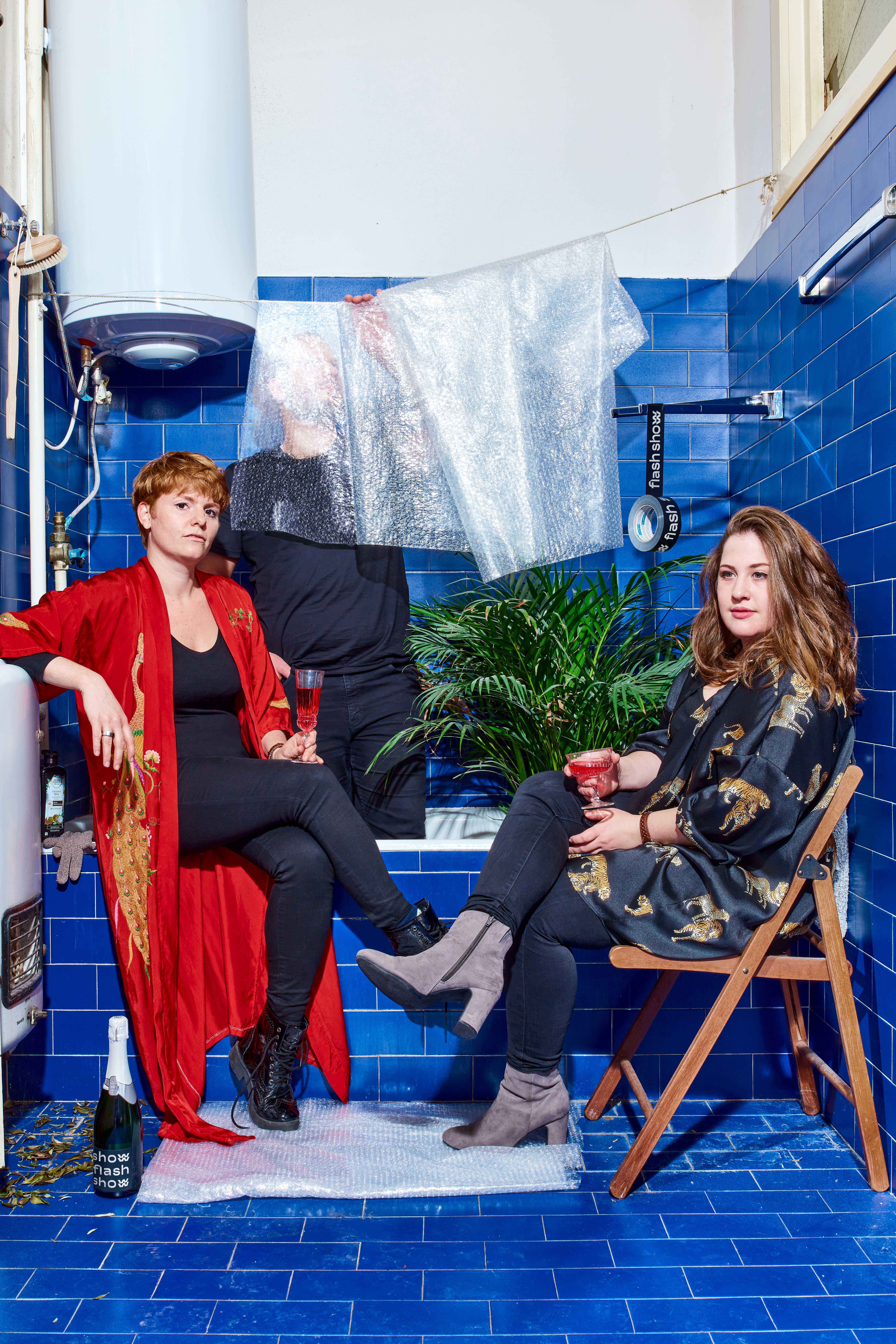
FLASH SHOW was established in 2019 as an alternative platform to traditional art fairs to support the emerging commercial galleries from the CEE region.
In pre-covid times, when there was no limit to the imagination, our concept looked like this: Each invited gallery will propose a solo show by one of its collaborating artists. Flash aims to deal with the given space and to compose a display of solo shows in the form of a selected group exhibition.
The FLASH SHOW 0. edition was invented to adapt to the virus; stepping out of the four walls, we move contemporary art of the Central Eastern European region to public spaces, more precisely into shop windows, in different parts of Budapest,
The concept of the solo show provides an opportunity for the viewers to immerse themselves much more than to get lost in a multitude of stimuli. We would like to ensure a high quality of international presence as well, so the galleries had been carefully selected by our curatorial team.
More info about the exhibitors and artists: https://www.flashshow.art/catalogue
facebook.com/flashshowbudapest
TEAM: Fruzsina KIGYÓS, Alexandra NAGY, Balázs RÁPOLTHY
Intern: Rita KOMPORDAY
Grafika: Andrea CSUPORT, Hajnalka ILLÉS
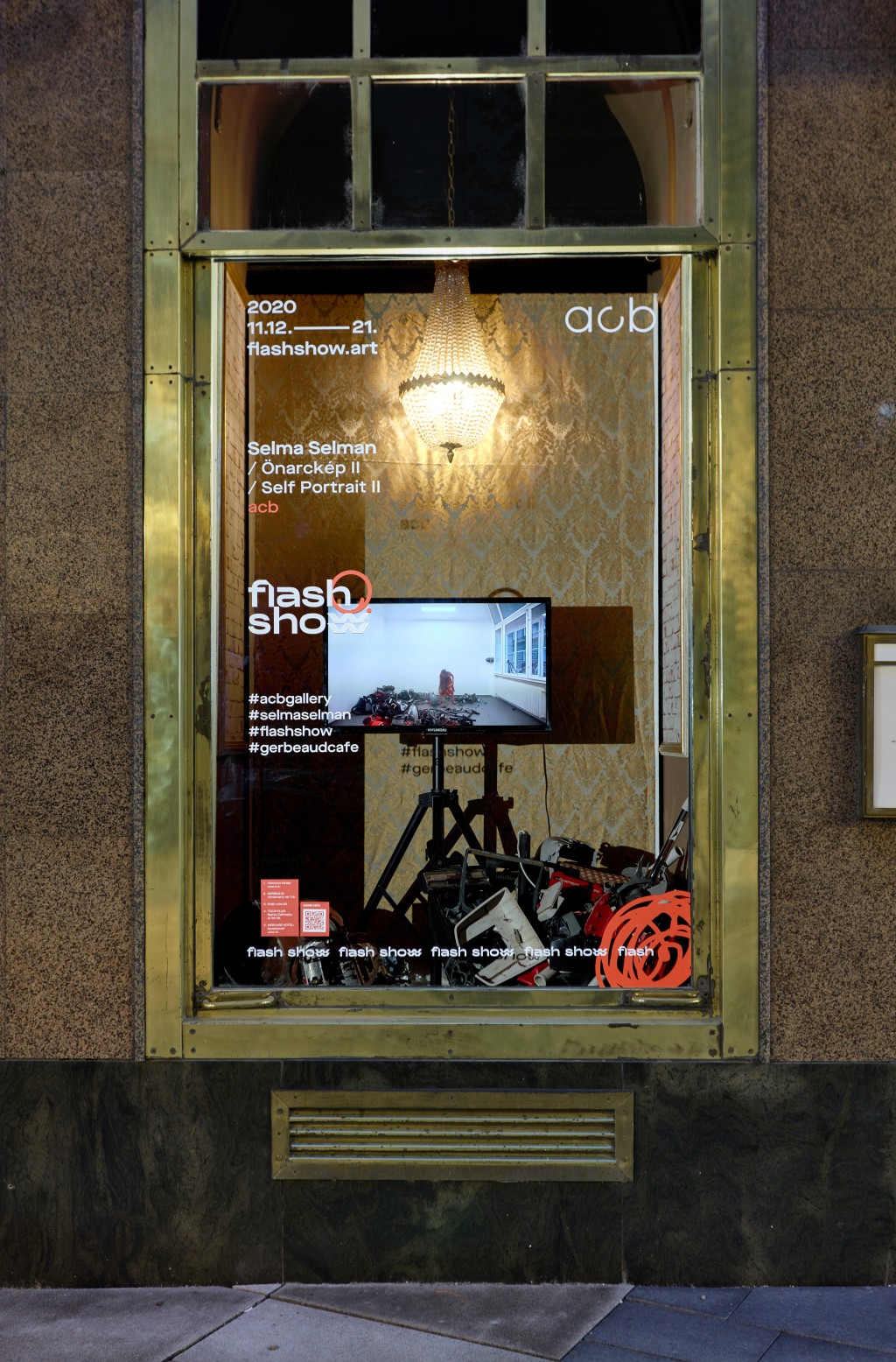
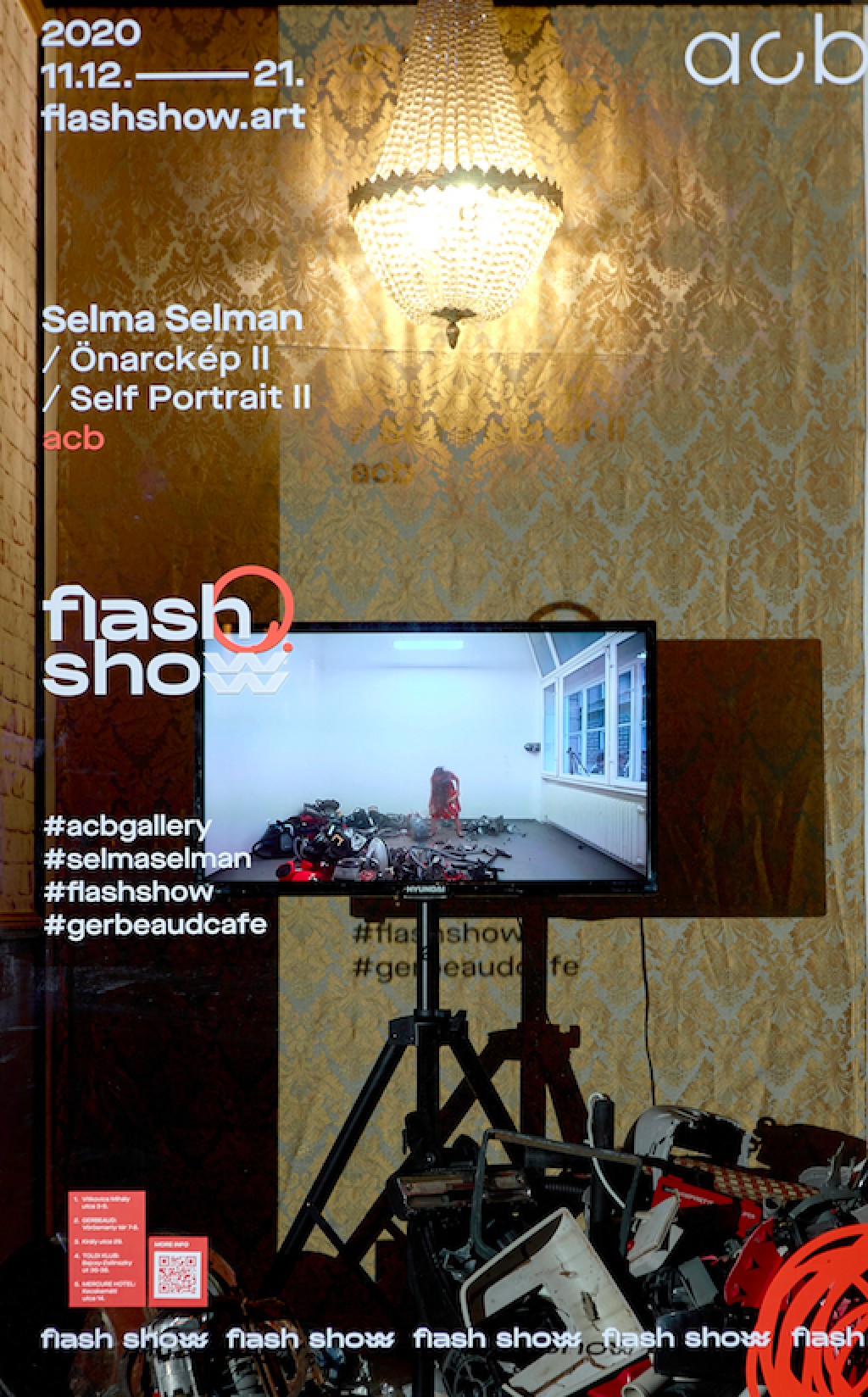
acb Gallery was founded in 2003 to represent contemporary and Hungarian neo-avant-garde art, both on the Hungarian and the international scene. Until 2009, the gallery’s program was focusing on the artistic practice of the generation that emerged in the 1990s in Hungary and mostly worked with non-traditional media. With a new management, the gallery has been extending its portfolio since 2009 with neo-avant-garde, emerging and international artists and has been positioning itself on the international art-scene. In 2013, acb opened its second exhibition space named acb Attachment, followed by a third space in 2016. In 2015 the gallery launched acb ResearchLab, a non-profit institute that focuses on the research and publication of Hungarian neo-avant-garde and post-avant-garde oeuvres. Throughout its research and wide exhibition activity, acb has played a key role in extending knowledge of the 1960s’ and 1970s’ Hungarian art, as well as in reviewing and completing the existing canon.
Selma Selman is one of the youngest and most exciting flag-bearers of a long tradition of critical and political performance from the ex-Yugoslav area, who works with performance, video, photography, drawing and painting. Her practice both embraces and blasts the stereotypes about Roma people by referring to her personal experience, life situations and stories, but also focusses on her own specific condition as a young woman artist of Roma origins from Bosnia. To continuously transcend her status and emancipate herself from all gender-based and racial discrimination, persecution, trauma and tension, she often uses her body as a loud speaker to convey her struggle, despair, anger, fear, resistance and fight for survival.
In her performance entitled Self-portrait – AEG Vampyr 1400 (2017), the young artist destroys a large number of hoovers with a fireman axe. Beyond the repeated reference to her family’s way to subsist, this performance stands for the destruction of a housework device that became associated with the enslaving of housewives for more than a century, but also a moment of catharsis when the artist can ease the inner tensions that both destroy and construct her.
Selma Selman’s ultimate aim is to protect and enable female bodies and enact a cross-scalar approach to collective self-emancipation of oppressed women. Her search for functional, contemporary political resistance stems from her personal experience with oppression from various directions and scales. Selman is also the founder of the organization ”Get The Heck To School” which aims to empower Roma girls all around the world who face poverty and social ostracization.
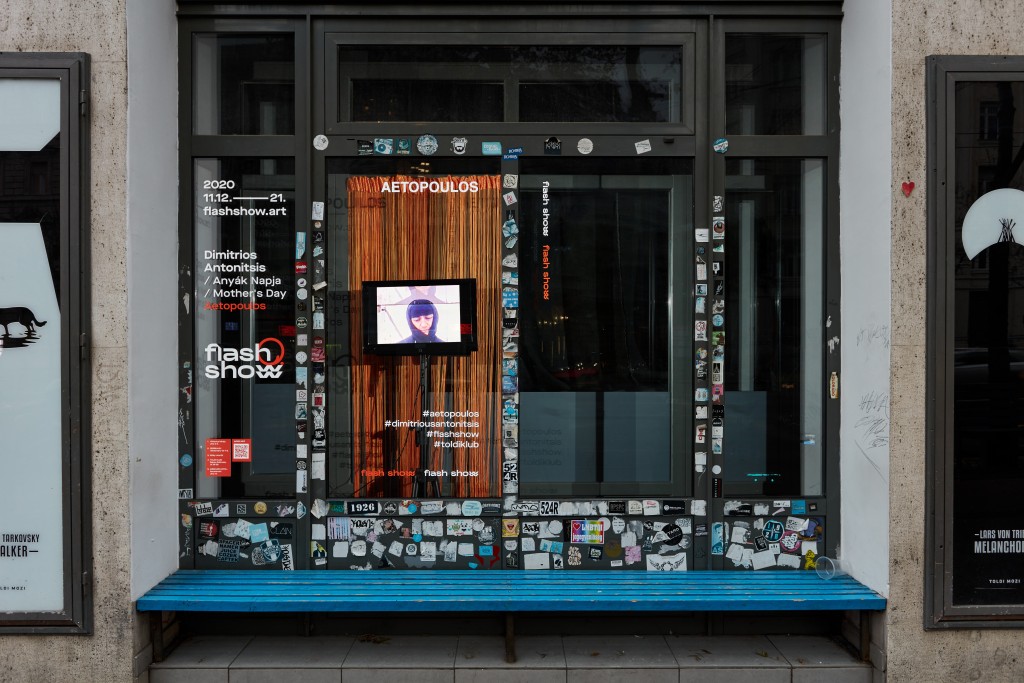
Aetopoulos was founded during the summer of 2016 by Greek born, New York based artist Alex Eagleton as a direct and personal response to the economic crisis. From there the program continues to materialize in the form of an exchange between international and Greek artists. We collaborate with galleries, guest curators and project spaces from all over.
Dimitrios Antonitsis was bornand lives in Athen. Dimitrios Antonitsis uses his latest sculptural work as a sharp metaphor of western principles such as overachievement, social power and luxurious consumption. His aesthetic language stretches from an attractive and minimal object
making to an overcharged and exaggerated folklore design, always responding to the objective of articulating the concepts as accurately as possible. To quote the late Rene Ricard: Antonitsis is an artist who feels responsible for bringing truth to his audience. He can be wrong or misunderstood, but he must struggle to reflect reality in a way that speaks the truth, whether we comprehend it or not.
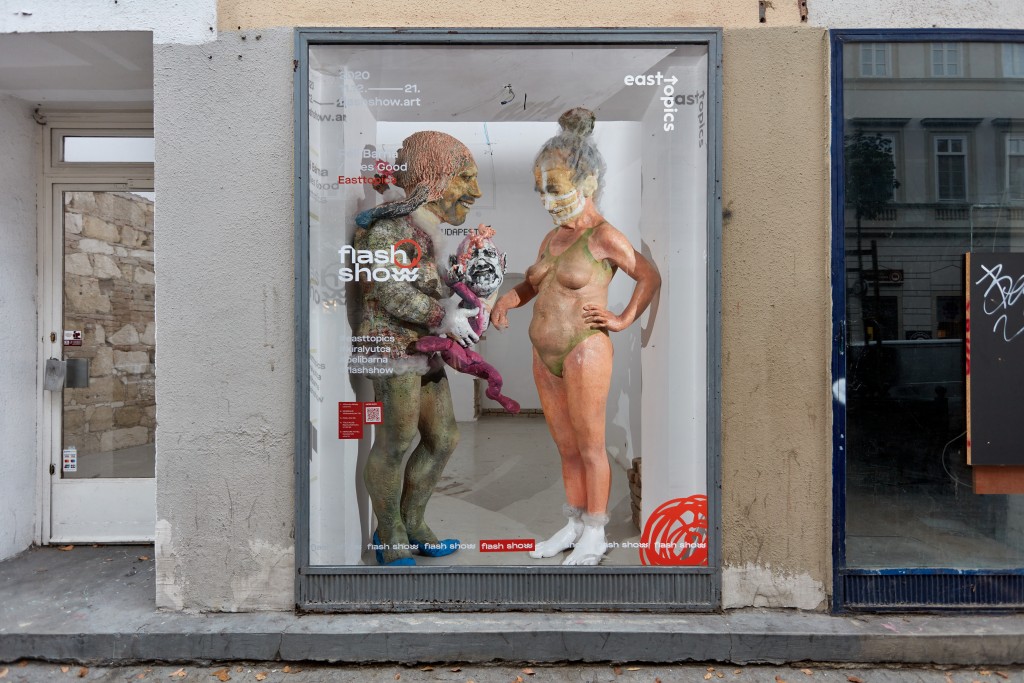
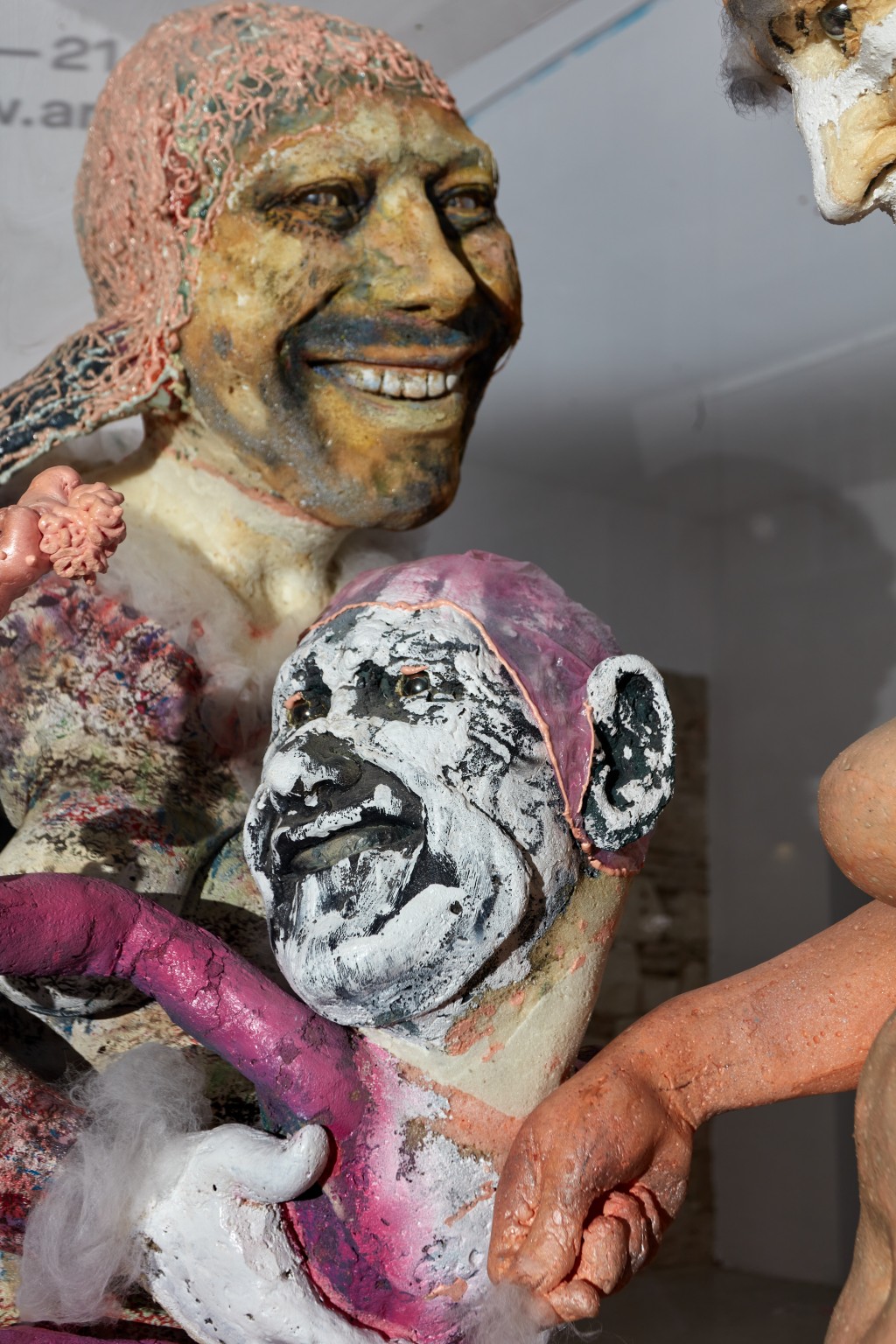
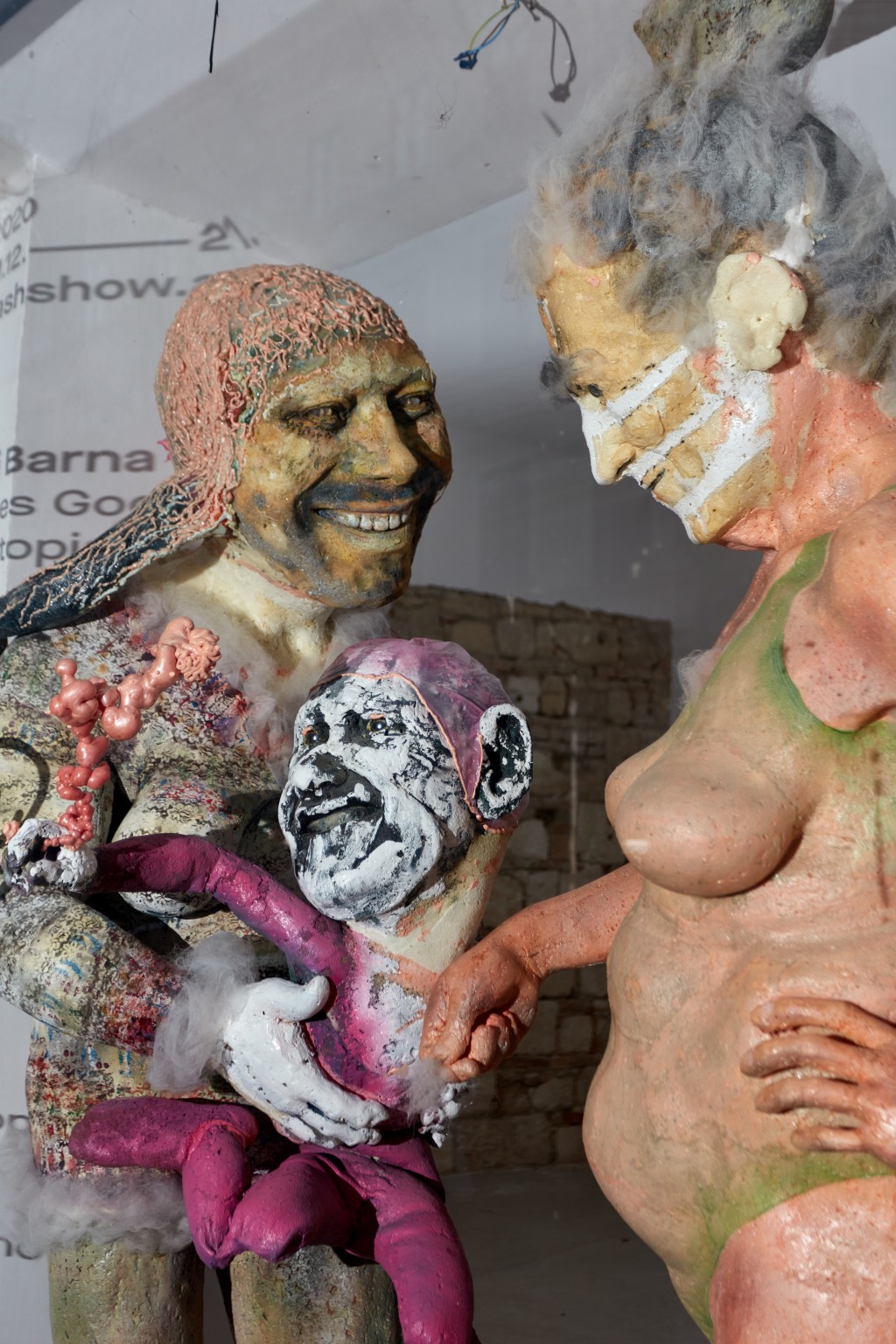
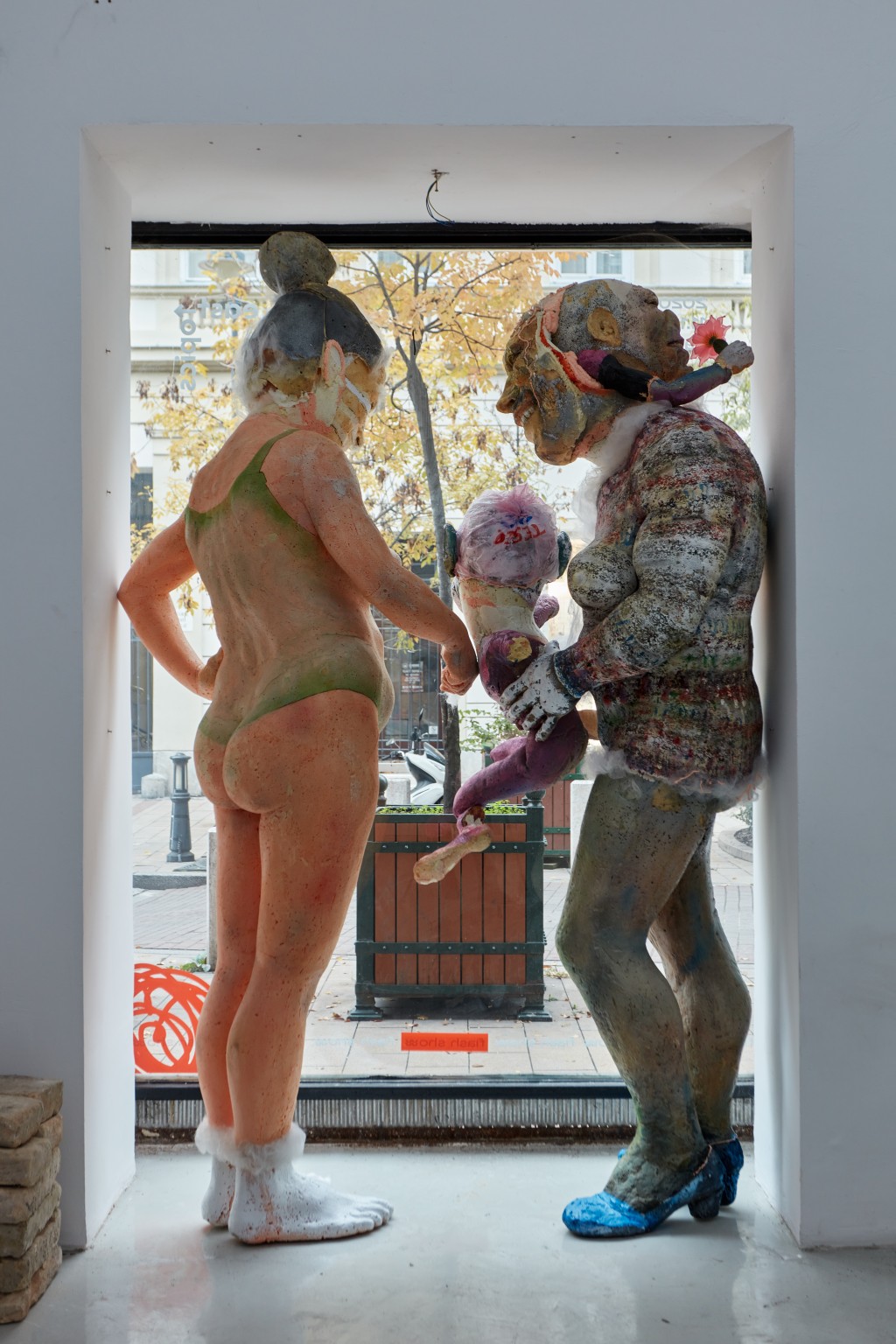

Easttopics aims at mapping and providing more visibility to protagonists of the Eastern European art life, should they be artists, art professionals, institutions, events or publications. It also wishes to act as a dynamic platform fostering connections, exchanges, community building, and cooperations for both practice-based and research-based projects on a local, regional, and international level.
Poised on the borderline between installation and sculpture, Barna Péli’s works enact situations. Each group of sculptures is an absurd story, replete with banal and complex references, as well as a hearty helping of the elements of a private mythology.
His most recent works freeze situations we know all too well, so we have a chance to study at length the essence of what are otherwise fleeting, decidedly fragile social connections. Alles Good, the work he has made for the Flash Show, depicts an encounter, where the two protagonists, The Capacity for Amazement and The Joy of Recognition jointly experience, and understand, the reassuring notion that while the present changes only slowly, or does not change at all, thinking about the future can bring calm.
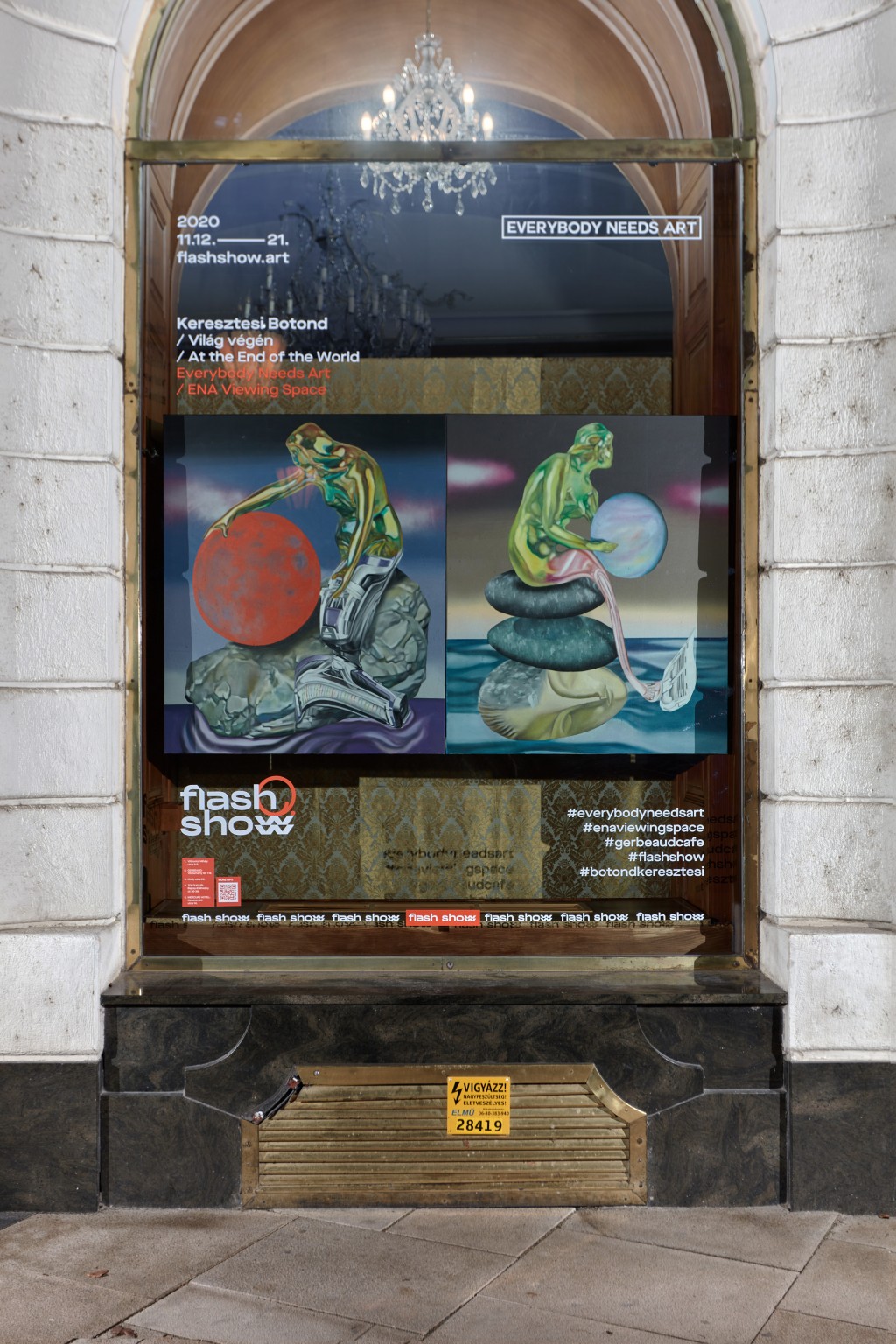
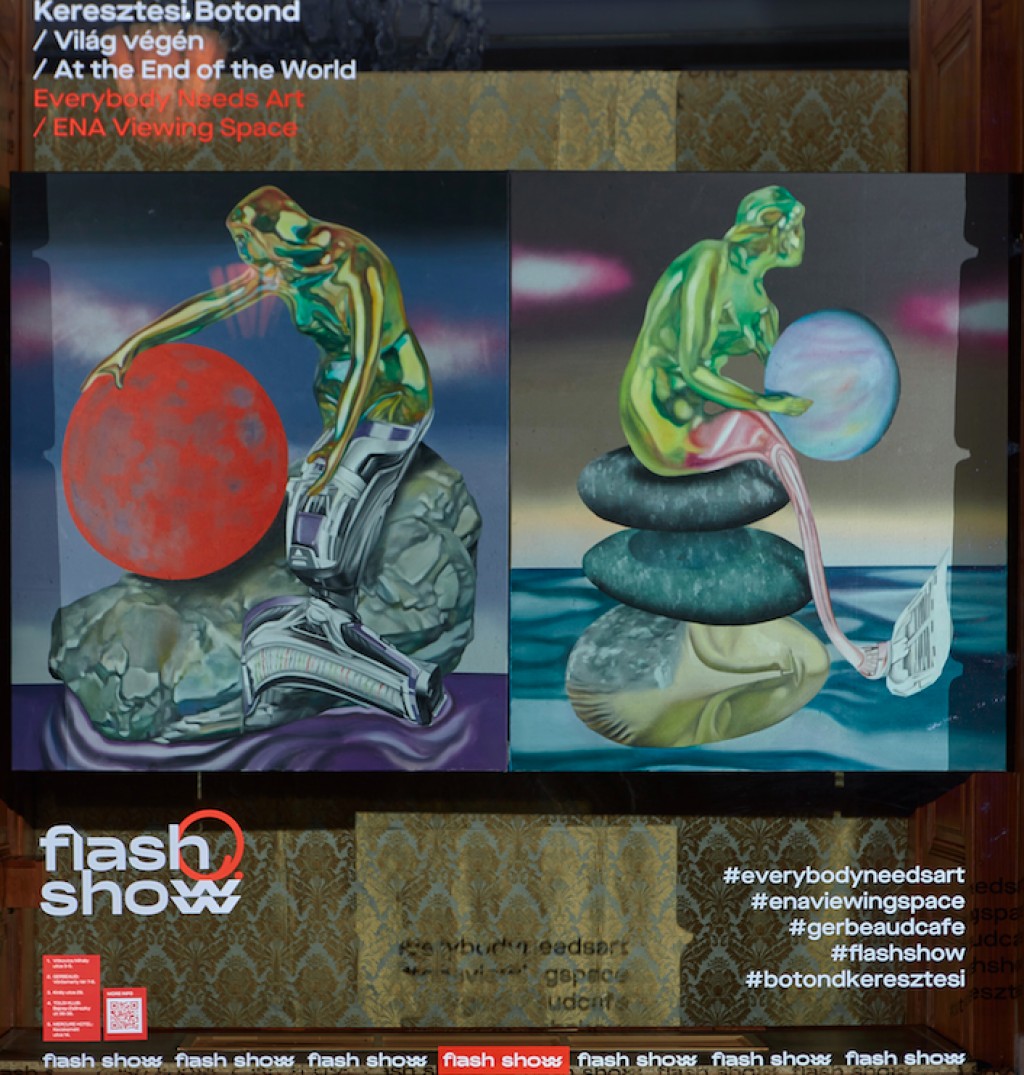
Everybody Needs Art [ENA] is a hybrid gallery system showcasing contemporary art internationally. The mission of ENA is to integrate contemporary art into everyday life in a variety of ways and forms. At the same time ENA represents and manages carefully selected artists by giving them opportunities to exhibit their work internationally in a wide variety of formats at the most distinguished venues. Throughout the year the ENA Viewing Space, located on a rooftop in Budapest, features exhibitions of contemporary work from these selected artists.
The works of Botond Keresztesi are connected to the medium and toolbar of painting. It can be tagged as traditional easel painting. He uses mostly photos as a starting point, which are often found on the internet about daily objects or taken by himself. Usually banal, well known, industrial motives are transformated into sacral meaning in one picture. The plain and the space or real and unreal confronting with each other in one collage. He is interested in the contrast of 2 dimensional surface and 3 dimensional object. The works are inspired by the early Hungarian avantgard painting and commercial posters from the 40’s (Sándor Bortnyik, Lajos Kassák and the movement of activism), the analytic cubism or the material culture of the 80’s and some commercials from the same age. They are also influenced by computer interfaces and the world of internet such as stock photos, textures and 3D effects.
The title of the exhibited works of Keresztesi is ‘At the end of the world’.
Maybe the end of the world means the final line of familiarity. For us, humans, 95% of the oceans and seas, which are covering the 70% of the globe, is unknown. Compared to our body it corresponds to our unused part of the brain or our subconscious. This area is full of mythology, strange creatures, some like just a Hieronnymus Bosch painting. In the ancient stories you can always find composed creatures, as the human brain can easily combine already existing materials in order to create something bizarre or never known. One great example is the mermaid phenomenon, that is very important, especially for civilizations who are living next to the sea, like the city of Copenhagen or Warsaw. In Denmark the meaning of this symbol is not clearly positive. Sometimes that is a good target for social messages. For example during the blm protests someone wrote “racist fish” on the rock where the little mermaid sits.
The iconic figure of the city of Warsaw is more like a protector. The official statue was initiated right before the beginning of 2nd world war. Right now it also has important role during the big protests against abortion laws. So the symbol seems a bit double sided, a bit complex. Keresztesi made a dystopian image of it , like a human remainder, a technological hybrid combining the culture of the past and the present from an imaginary’s point of view.
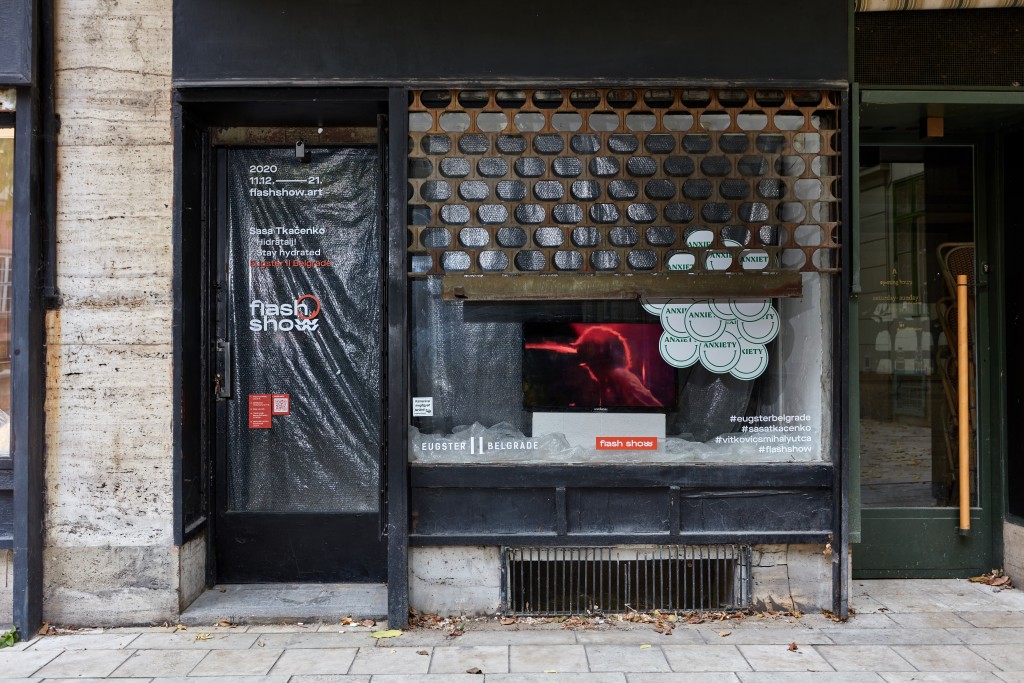
Eugster || Belgrade was founded in 2017. The gallery presents contemporary art from the south-east of Europe. The gallery explores the diverse local identities in dialog with international artistic practices, global events and urgent topics.
Saša Tkačenko currently lives and works in Belgrade. His artistic practice is based on appearances of spaces and their transformation when exposed to other media, as well as translating their architectural features to fields of sculpture and installation. Tkačenko’s works thus create dynamic situations in which the audience plays a constituent part.
The video Stay hydrated shows Kurt Cobain taking a bottle of water during one of his performances and spitting it in short jets in the direction of the audience. If you have ever attended a rock concert, this gesture is nothing unusual, on the contrary, it is a sign that the atmosphere at the concert is very intimate and that the concert is successful. This harmless sequence, set in the present moment, exposes all the fragility of the modern man who, striving for perfection, neglected everything outside that seductive simulacrum. Stickers glued to the glass further emphasise the paradoxical and dramatic nature of the moment we live in.
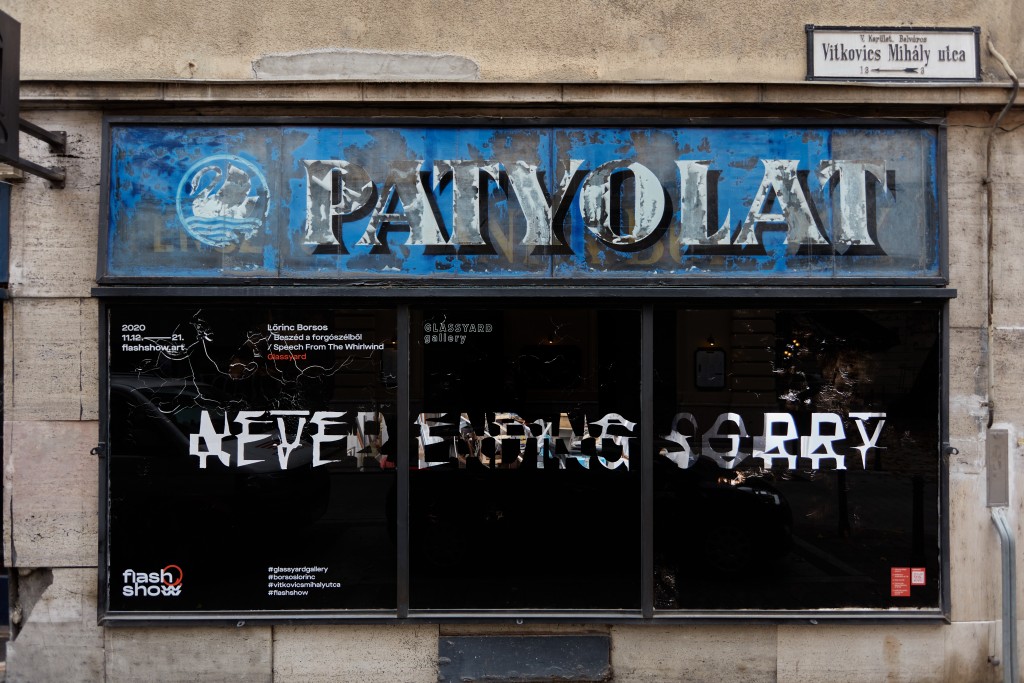
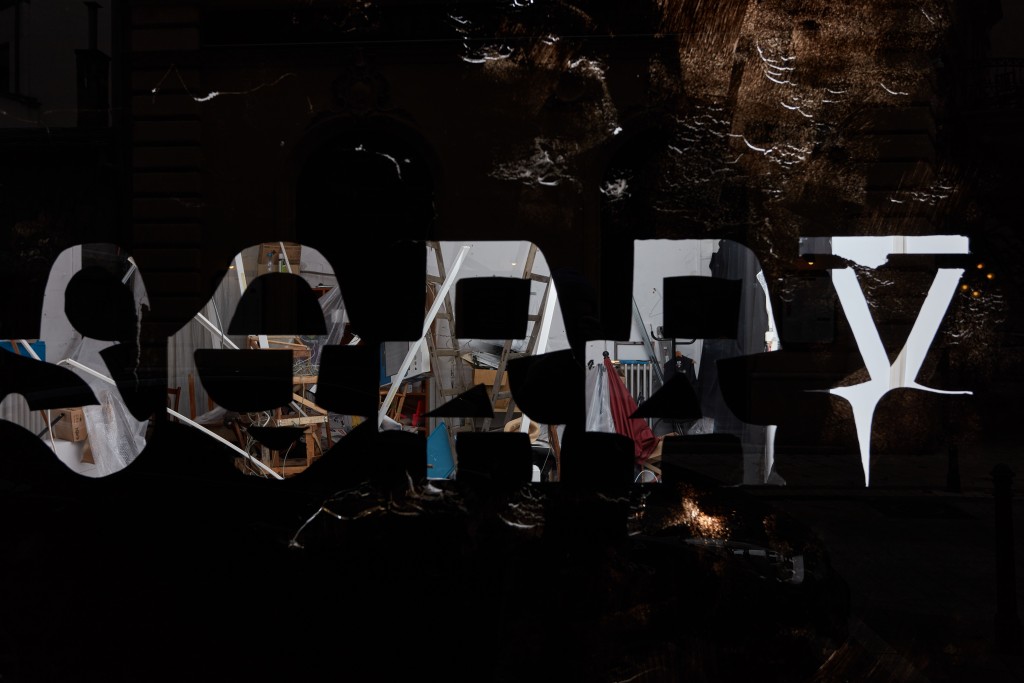
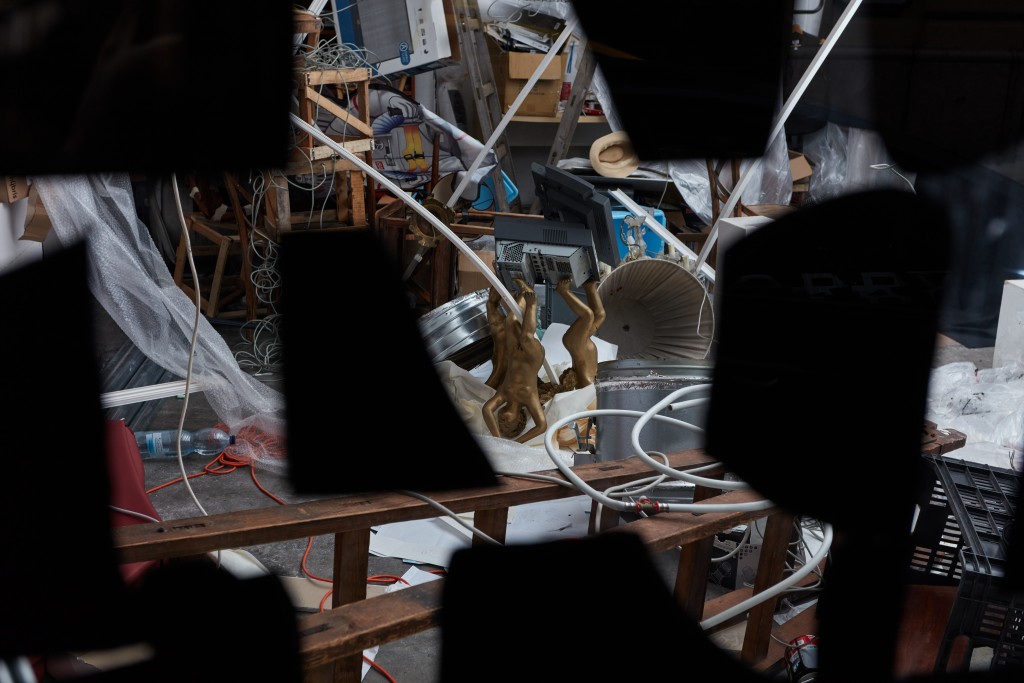
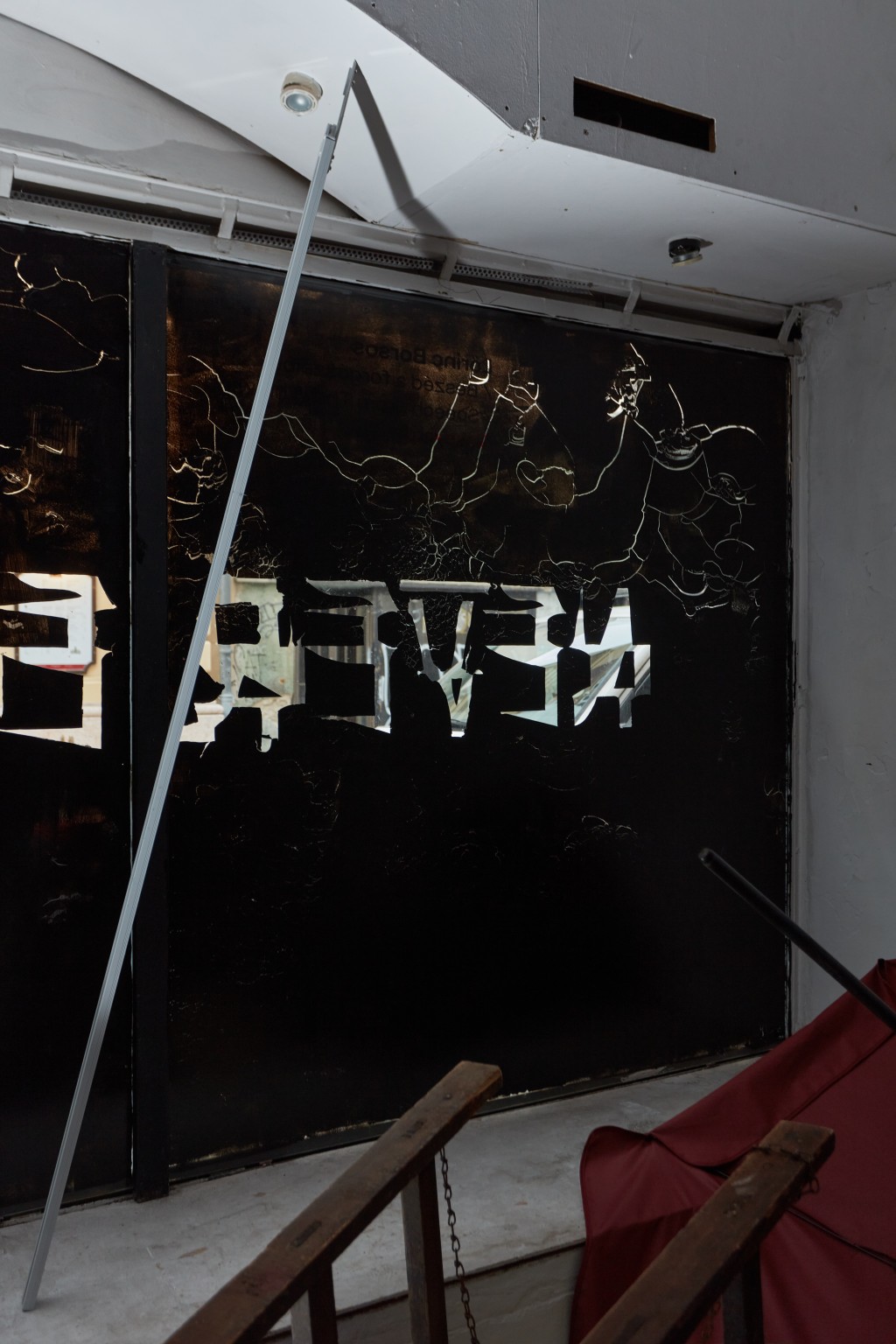
Glassyard Gallery represents and shows Hungarian and international artists, fosters collaborations between for-profit galleries and independent curators. With a solid presence in Budapest, the Gallery aims to further develop the international visibility of the represented artists through cooperation with galleries and institutions outside Hungary. Glassyard Gallery is intending to be a venue of an intensive exchange of ideas, reflections and critical positions and aspires to be a place inspiring artists and the audience with an impact on the public discourse. The exhibition program is based on curatorial practice that encourages close collaborations with the artists and through the solo and group exhibitions it provides a supportive ambiance for artistic experiments.
Glassyard Gallery was founded by Barnabás Bencsik, curator and former director of Ludwig Museum, Budapest and Tünde Csörgő in September 2017. The gallery venue is located in the heart of the town on the first floor in a spacious four-room flat of a late 19th century building of Budapest.
The fictitious artist Lőrinc Borsos – not someone to shy away from technological innovation – was created by artists János Borsos and Lilla Lőrinc, and was initially interested in examining questions of national self-representation, and later in those relating to contemporary social problems. More recently, Borsos has concentrated more and more on the medium of painting itself, and specifically on black paint: the extent to which it can be directed, its relationship to its environment, and its dependence on external influences.
Lőrinc Borsos’ installation is a peculiar commentary on the Book of Job from the Bible. With the help of their iconic material, the shiny black enamel paint, which at the same time absorbes and reflects light, the artist couple flashes and unifies their themes: in this specific case they evoke the image of the Creator continally apologizing (Neverending Sorry) for the imperfections of the world.
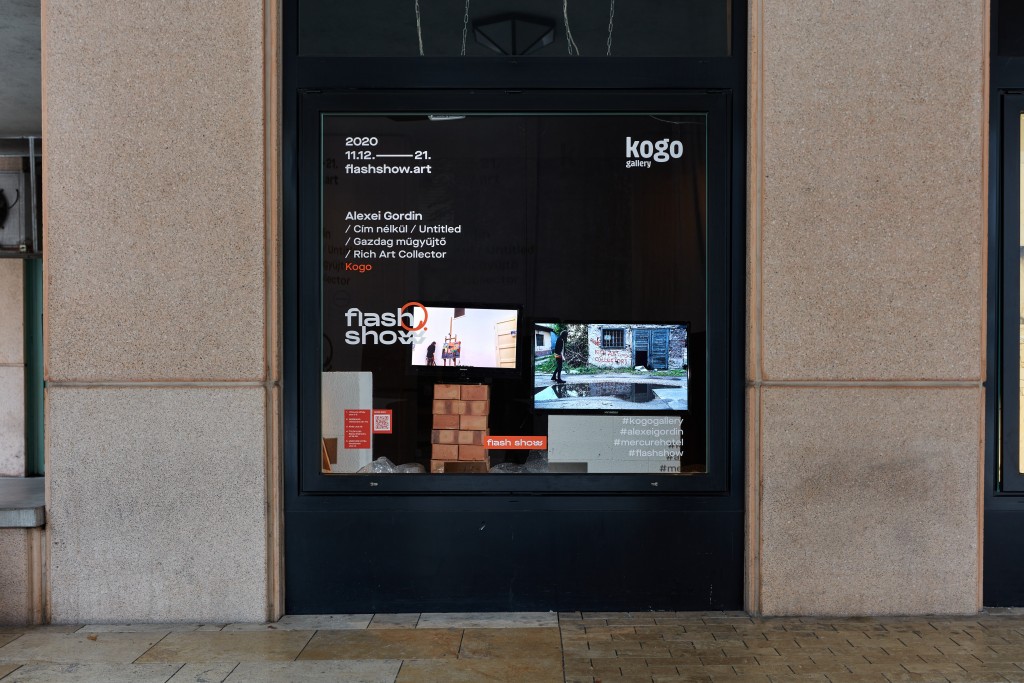
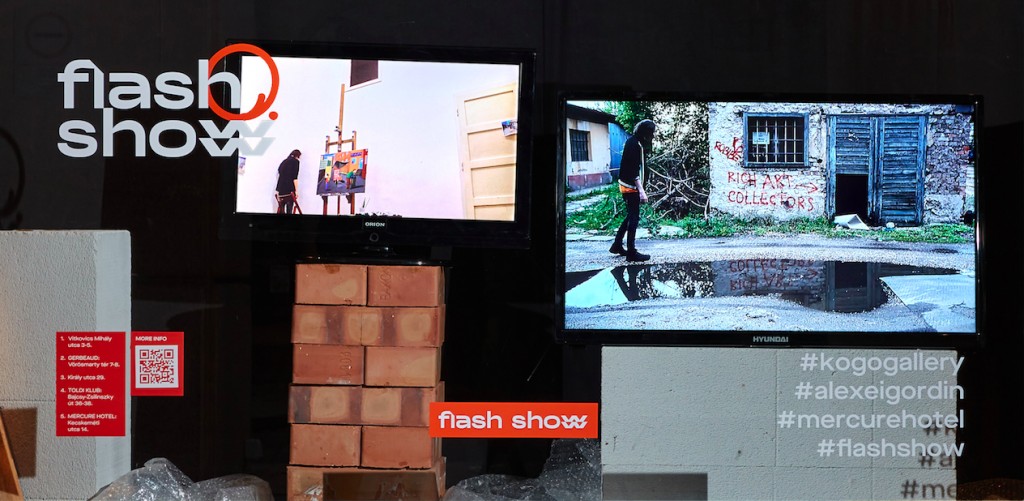
Kogo is a contemporary art gallery representing outstanding emerging and mid-career Estonian and international artists. Kogo’s aim is to help the artists with their international visibility and to create professional contacts as well as support their artistic freedom, interdisciplinarity, and freshness in ideas. The gallery’s program is focused on artists’ solo projects, curatorial projects, and exhibitions born out of cooperation between artists.
Tallinn based artist Alexei Gordin is a tongue in cheek storyteller and flâneur whose narratives are built on his own life as an artist. Gordin’s ironical, social critical works performed in different mediums reveal absurdly stereotypical behaviour patterns of people. Video performance “Untitled” takes place in the gloomy studio where artist gets possessed by the flickering lights while “Rich Art Collectors” film lets us follow Gordin’s journey through abandoned industrial territories with a mission to find collectors.
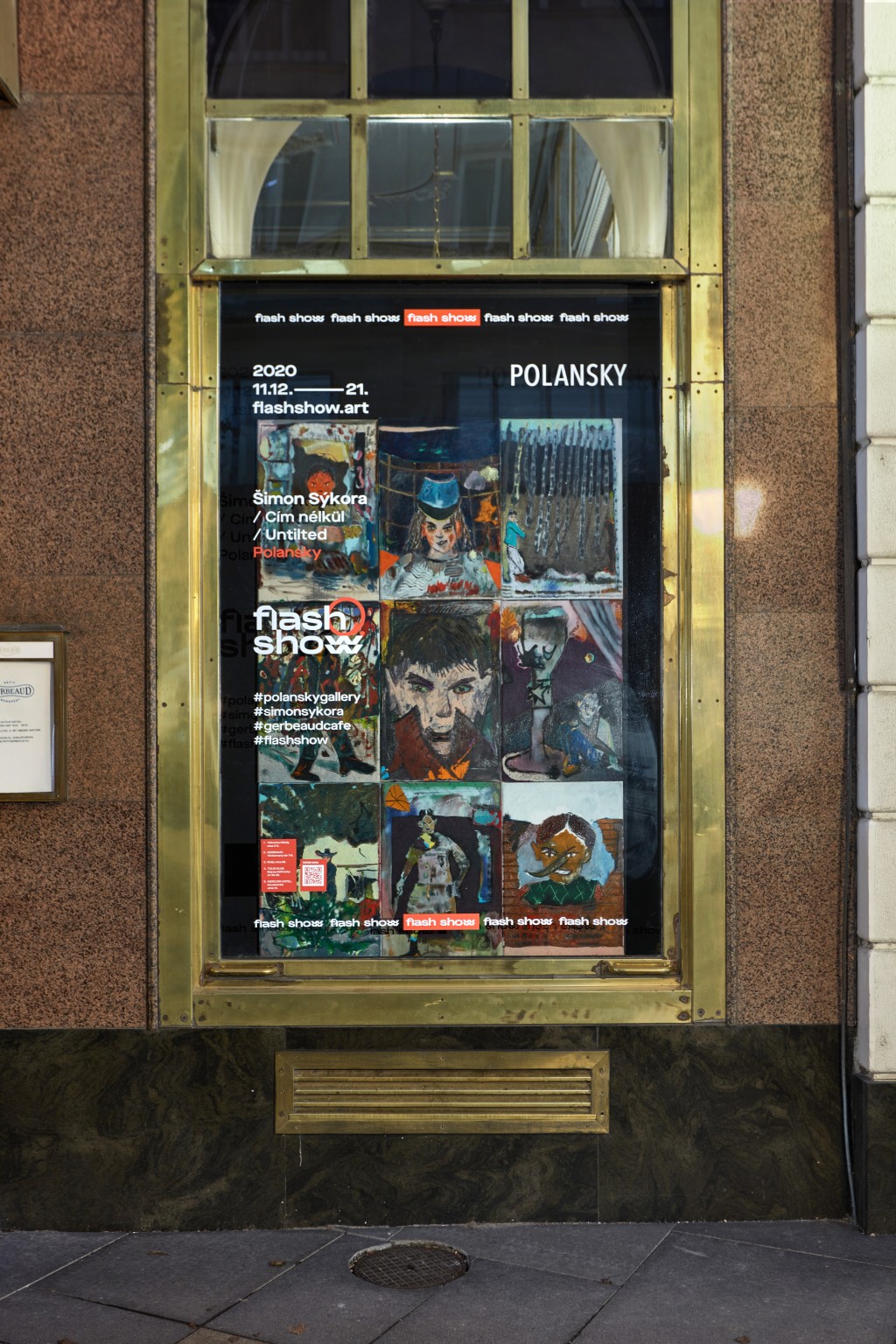
Polansky Gallery is one of few Czech galleries working internationally on a constant quality level. Its mission has been to enforce Czech and Central-European art in the international context. On the other hand, the aim is also to introduce interesting and various positions of international art in Prague. The gallery collaborates with both young and established artists working with all media.
The comfortably melancholy works of Šimon Sýkora invite the viewer into a kind of hazy realm of wanderers and misfits. As if given the cold shoulder by a passing acquaintance, Sykora’s paintings do not open themselves as much as make one feel like a voyeur overhearing mumbled conversations. Sykora’s compositions are largely comprised of shadowy figures resting, meandering, or passively daydreaming in recognizably disheveled spaces. Existing in a reality that is almost violently Bataillean, the works explore the more internalized notions of the human condition-rather imperceptible, but agonizingly present and powerful in shaping one’s entire reality. Within the work, washes of anxiety, disappointment, regret, loneliness, mourning, and longing come to the fore.
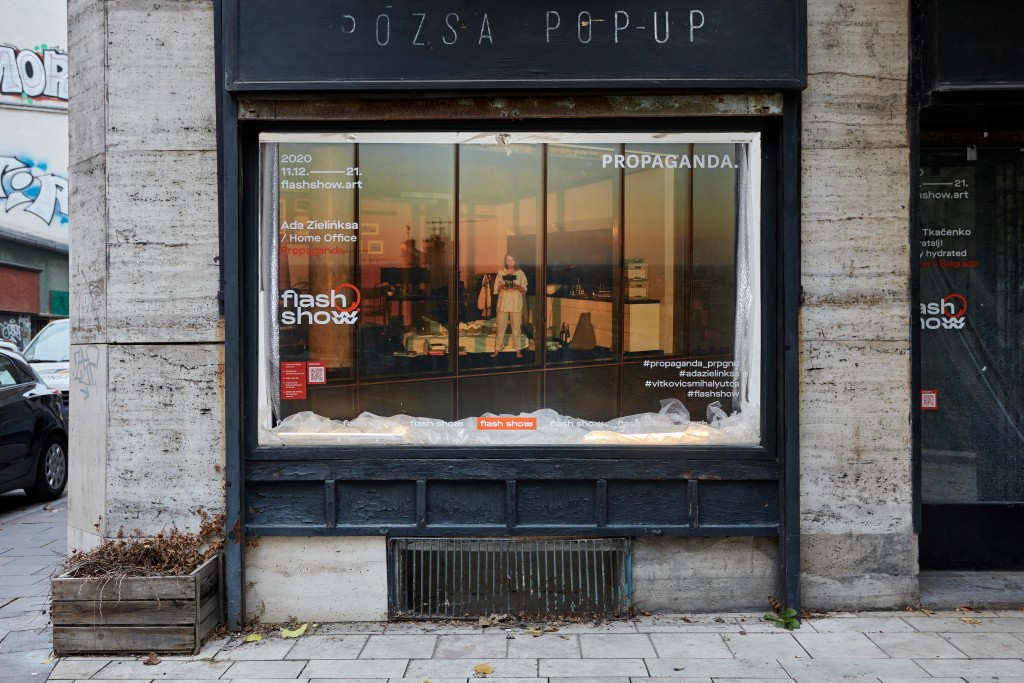
Propaganda is a Warsaw-based contemporary art organisation dedicated to producing and promoting art created by both well established and emerging artists, and also active in the field of publishing and film production/distribution. For more than ten years it has been one of the most important institutions in Warsaw, contributing to polish art landscape among others by co-creating Warsaw Gallery Weekend – one of the biggest annual art events in the CEE region, as well as organising many art exhibitions and multidisciplinary projects.
Ada Zielińska is a visual artist, she is working in the field of photography and installation. In her works she tries to document the catastrophe surrounding her, confront with disintegration. At the same time, she observes her attraction to these. In effect, her works are an attempt to capture a moment of power at the time of total disintegration. These observed moments serve a specific self-therapy, and photographs of these apparent accidents take the form of the author’s note about the world around her, an effort to control what is inevitably going to an end.
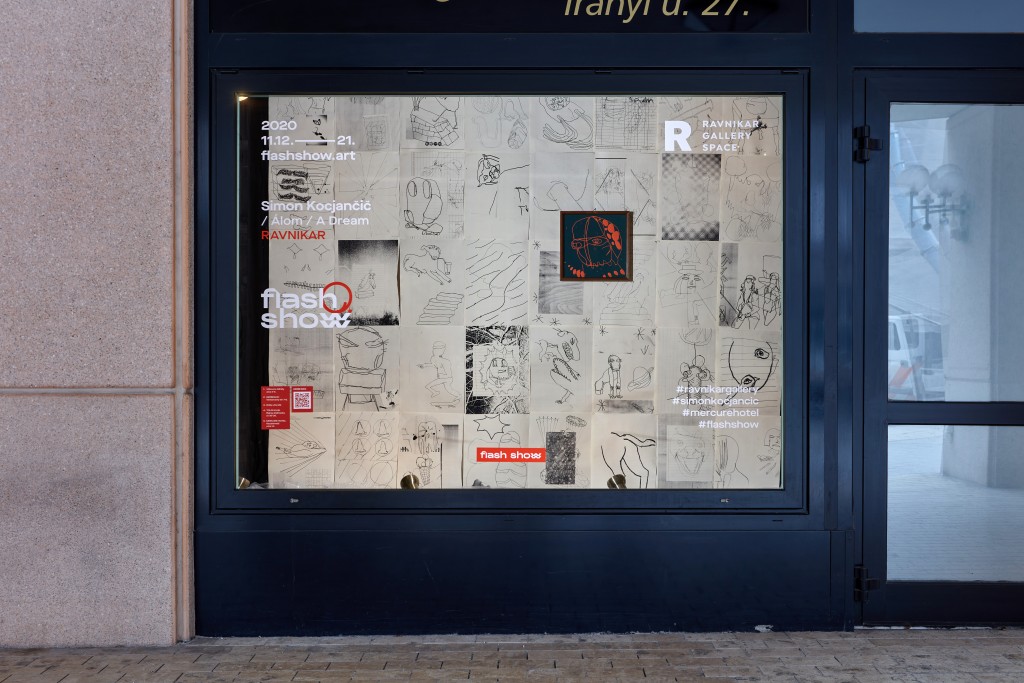
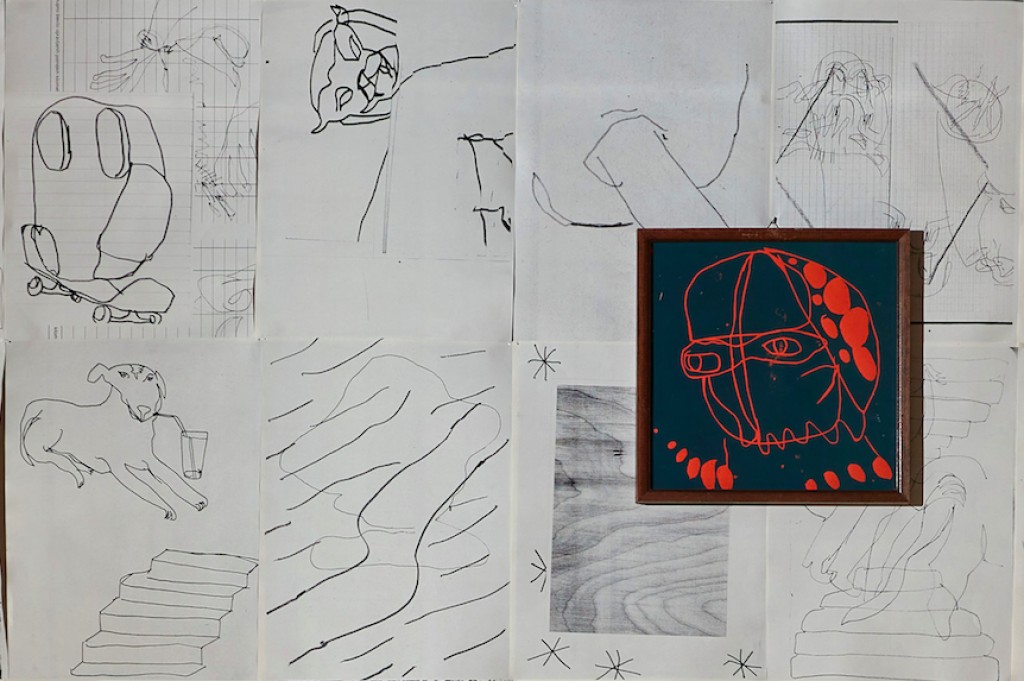
RAVNIKAR GALLERY SPACE is a contemporary art gallery in the heart of Ljubljana. Founded by Piera Ravnikar in 2017, the gallery’s mission is to open up new dialogues between visual artists and the public. R — s p a c e provides a venue for a thriving community of established and emerging artists, representing a broad range of creative practices and media.
Simon Kocjančič devotes his talents to drawing, painting and artistic fanzines. His paintings are a mass of colour and shape, where undefined or half-recognisable motifs create fragile and enticing compositions between the figurative and the abstract. The artist’s distorted images are never restricted by logic, and so they invite an infinite array of interpretations. This absence of a narrative allows for anticipation, emotion and adventure. Simon’s choice of colour and form boldly contrasts the predictable with the unfamiliar. Existing images often serve as a basis for his work, though a memory or feeling will sometimes be enough. Through a process of experimentation, Simon connects a multitude of fragments into a coherent whole, which often has very little in common with his starting point.
From the very beginning, the artist has experimented with his own shades of oil paint, avoiding the use of pure, primary colours at all costs. In recent years, especially for large formats, Simon also opts for acrylic and wall paint, which he applies with pronounced brushstrokes. The viewers of his paintings find themselves in the awkward position of not being able to name the colour they are looking at. Is that blue? Or grey?
Sometimes he ventures into the figurative, where outlines of grotesque, hybrid monsters begin to appear, and on other occasions he prefers soft abstraction. His favourite habitat is the space in-between, where his intuitive strokes create a unique, authentic image and a conscious shift from reality.
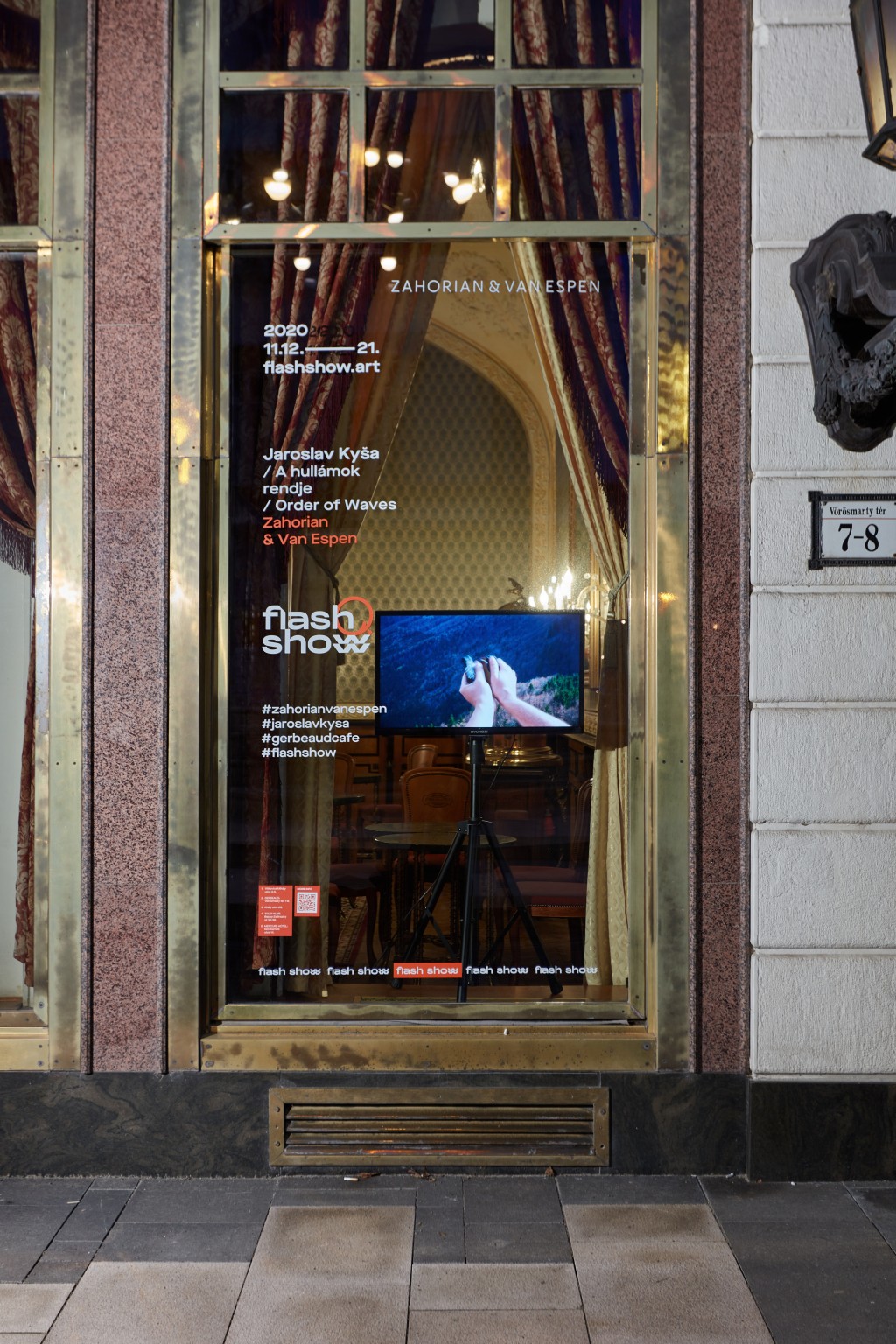
ZAHORIAN & VAN ESPEN is a contemporary art gallery based in Prague /Czech Rep/ and Bratislava /Slovakia/. Since its foundation in 2011, it has become one of the leading galleries in the region, representing both established artists and emerging talent. By establishing a strong portfolio and distinctive curatorial approach, the gallery seeks to connect local artists with the global art scene, showcasing their work not only in its gallery spaces but also at international art fairs. The gallery also closely collaborates with other European, US-based galleries. In addition to its rich exhibition program, the gallery is dedicated to supporting the production of art works and publishing activities, focusing on catalogues and monographic publications dedicated to individual artists. In doing so, the gallery cooperates with international curators from France, UK, Italy, and USA.
Moreover, the gallery offers a variety of public lectures and professional initiatives to promote contemporary art, thus playing a central role in the broader cultural landscape of the Central European region.
The experimental film depicts the artist in private minimalist performances shattering a deeply held belief about the nature and properties of the time narrative. Kyša uses various found materials and objects symbolising historical layers of time. He distorts, manipulates and transfers them to new contexts. We see a divine personification of the author/creator who makes decisions and disputes the fate and historical background of selected objects. He holds a 400-million-year-old trilobite fossil in his hand and grinds it to cause its complete extinction. In a short time, he destroys this once-living organism and the symbol of ancient history. In the next image, he considers the past and the future existence of the fist wedge. Will he destroy it or spare its life? How long did the calcium stalactite from under the bridge grow until Kyša tore it off to point out the instability of the concept of time?
At the same time, the author’s gesture draws attention to the difference between destruction in the context of artistic operation and the barbaric rage that we have witnessed in recent years. Just remember attacks of the Islamists who destroyed Assyrian sculptures and excavations in the town of Nimrud in 2015, or the irresponsible action of the Lidl supermarket chain, which destroyed the 1960s sculpture of Jozef Jankovič in Ružinov in Bratislava in 2011. The systematic destruction of the Jewish cultural heritage during the communist regime is infamously known. Apparently, the strategy of destruction in Jaroslav Kyša’s work has a more poetic character and symbolic meaning. Rather than the physical destruction of objects, he is more interested in a short-term or final change of state, using this form to communicate short video stories.
text: Michal Stolárik
